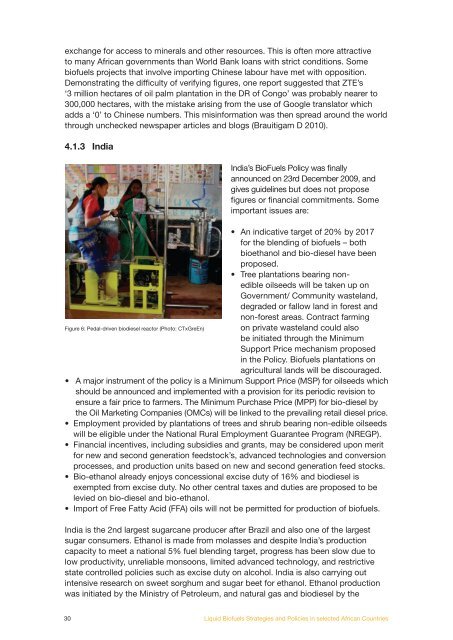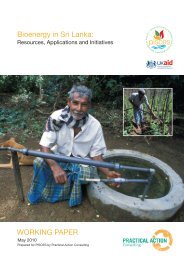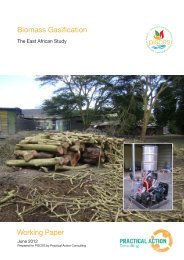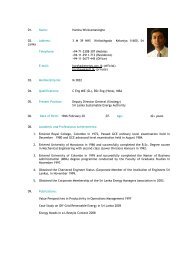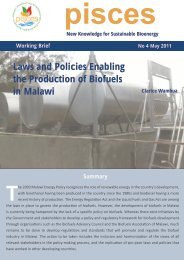Liquid Biofuels Strategies and Policies in selected African ... - Pisces
Liquid Biofuels Strategies and Policies in selected African ... - Pisces
Liquid Biofuels Strategies and Policies in selected African ... - Pisces
You also want an ePaper? Increase the reach of your titles
YUMPU automatically turns print PDFs into web optimized ePapers that Google loves.
exchange for access to m<strong>in</strong>erals <strong>and</strong> other resources. This is often more attractiveto many <strong>African</strong> governments than World Bank loans with strict conditions. Somebiofuels projects that <strong>in</strong>volve import<strong>in</strong>g Ch<strong>in</strong>ese labour have met with opposition.Demonstrat<strong>in</strong>g the difficulty of verify<strong>in</strong>g figures, one report suggested that ZTE’s‘3 million hectares of oil palm plantation <strong>in</strong> the DR of Congo’ was probably nearer to300,000 hectares, with the mistake aris<strong>in</strong>g from the use of Google translator whichadds a ‘0’ to Ch<strong>in</strong>ese numbers. This mis<strong>in</strong>formation was then spread around the worldthrough unchecked newspaper articles <strong>and</strong> blogs (Brauitigam D 2010).plann<strong>in</strong>g commission <strong>in</strong> 2003 with the M<strong>in</strong>istry of Rural Development responsiblefor identify<strong>in</strong>g the best feedstock. With<strong>in</strong> this new policy all activities have beenharmonised under a central M<strong>in</strong>istry of New <strong>and</strong> Renewable Energy, which isempowered to coord<strong>in</strong>ate with other M<strong>in</strong>istries.4.1.3 IndiaIndia’s BioFuels Policy was f<strong>in</strong>allyannounced on 23rd December 2009, <strong>and</strong>gives guidel<strong>in</strong>es but does not proposefigures or f<strong>in</strong>ancial commitments. Someimportant issues are:• An <strong>in</strong>dicative target of 20% by 2017for the blend<strong>in</strong>g of biofuels – bothbioethanol <strong>and</strong> bio-diesel have beenproposed.• Tree plantations bear<strong>in</strong>g nonedibleoilseeds will be taken up onGovernment/ Community wastel<strong>and</strong>,degraded or fallow l<strong>and</strong> <strong>in</strong> forest <strong>and</strong>non-forest areas. Contract farm<strong>in</strong>gFigure 6: Pedal-driven biodiesel reactor (Photo: CTxGreEn) on private wastel<strong>and</strong> could alsobe <strong>in</strong>itiated through the M<strong>in</strong>imumSupport Price mechanism proposed<strong>in</strong> the Policy. <strong>Biofuels</strong> plantations onagricultural l<strong>and</strong>s will be discouraged.• A major <strong>in</strong>strument of the policy is a M<strong>in</strong>imum Support Price (MSP) for oilseeds whichshould be announced <strong>and</strong> implemented with a provision for its periodic revision toensure a fair price to farmers. The M<strong>in</strong>imum Purchase Price (MPP) for bio-diesel bythe Oil Market<strong>in</strong>g Companies (OMCs) will be l<strong>in</strong>ked to the prevail<strong>in</strong>g retail diesel price.• Employment provided by plantations of trees <strong>and</strong> shrub bear<strong>in</strong>g non-edible oilseedswill be eligible under the National Rural Employment Guarantee Program (NREGP).• F<strong>in</strong>ancial <strong>in</strong>centives, <strong>in</strong>clud<strong>in</strong>g subsidies <strong>and</strong> grants, may be considered upon meritfor new <strong>and</strong> second generation feedstock’s, advanced technologies <strong>and</strong> conversionprocesses, <strong>and</strong> production units based on new <strong>and</strong> second generation feed stocks.• Bio-ethanol already enjoys concessional excise duty of 16% <strong>and</strong> biodiesel isexempted from excise duty. No other central taxes <strong>and</strong> duties are proposed to belevied on bio-diesel <strong>and</strong> bio-ethanol.• Import of Free Fatty Acid (FFA) oils will not be permitted for production of biofuels.India is the 2nd largest sugarcane producer after Brazil <strong>and</strong> also one of the largestsugar consumers. Ethanol is made from molasses <strong>and</strong> despite India’s productioncapacity to meet a national 5% fuel blend<strong>in</strong>g target, progress has been slow due tolow productivity, unreliable monsoons, limited advanced technology, <strong>and</strong> restrictivestate controlled policies such as excise duty on alcohol. India is also carry<strong>in</strong>g out<strong>in</strong>tensive research on sweet sorghum <strong>and</strong> sugar beet for ethanol. Ethanol productionwas <strong>in</strong>itiated by the M<strong>in</strong>istry of Petroleum, <strong>and</strong> natural gas <strong>and</strong> biodiesel by theFigure 7: Biodiesel Production from Jatropha (Photo: Raffaella Bellanca)India has focused ma<strong>in</strong>ly on jatropha for biodiesel feedstock. With more than 1 millionjatropha trees planted across 16 states (well short of <strong>in</strong>itial targets), <strong>and</strong> anothermillion expected to be planted soon, the major problem has been with its lower thanexpected yields, <strong>and</strong> higher than expected costs of cultivation.There is still a huge shortage of supply aga<strong>in</strong>st dem<strong>and</strong> <strong>in</strong> India, with a lot of seedbe<strong>in</strong>g used for plant<strong>in</strong>g, <strong>and</strong> oil companies offer<strong>in</strong>g lower prices than productioncosts. One commentator noted that with the common use of vegetable oil lamps forlight<strong>in</strong>g <strong>in</strong> homes <strong>and</strong> temples, many people have turned to buy<strong>in</strong>g cheaper ‘biokerosene’(unref<strong>in</strong>ed biodiesel) depriv<strong>in</strong>g the larger biodiesel <strong>in</strong>dustry of its oil supply.He also noted that the manual collection of non-edible oil seeds is a huge logisticalchallenge for large biodiesel plants. A total of 15,000 people are needed for 3 months,once or twice a year, to gather 100 tons of seeds per day, produc<strong>in</strong>g 8 million gallonsper year. India’s biodiesel process<strong>in</strong>g capacity is estimated at 600,000 tons per year.The government is now likely to fix a price of Rupees 34 a litre for the purchase ofbiodiesel by oil market<strong>in</strong>g companies.4.1.4 MalaysiaMalaysia passed its National <strong>Biofuels</strong> Policy <strong>in</strong> March 2006, which falls under theM<strong>in</strong>istry of Plantation Industries <strong>and</strong> Commodities. Malaysia is the world’s largestpalm oil producer hav<strong>in</strong>g started its programme <strong>in</strong> 1982. It established the nationalB5 st<strong>and</strong>ard <strong>in</strong> the short term with <strong>in</strong>itial voluntary uptake as well as sett<strong>in</strong>g itselfup as a major exporter. Incentives were awarded under the Pioneer Status orInvestment Tax Allowance if they were considered strategic, high technology or<strong>in</strong>cluded commercialisation of R&D f<strong>in</strong>d<strong>in</strong>gs for the public sector <strong>and</strong> resource-based<strong>in</strong>dustries. While both Malaysia <strong>and</strong> Indonesia have very suitable climates for palmoil production, Malaysia has long s<strong>in</strong>ce <strong>in</strong>dustrialised its forests <strong>in</strong>to rubber <strong>and</strong>palm plantations with little <strong>in</strong>digenous forest left. Malaysia’s goal was for the shareof renewable energy to reach 10% of the total by 2010. In 2010, Malaysia m<strong>and</strong>atedthat by 2011 all vehicles must utilize a B5 biodiesel/diesel fuel blend conta<strong>in</strong><strong>in</strong>g fivepercent processed palm oil (AFP, 2010).30 <strong>Liquid</strong> <strong>Biofuels</strong> <strong>Strategies</strong> <strong>and</strong> <strong>Policies</strong> <strong>in</strong> <strong>selected</strong> <strong>African</strong> Countries <strong>Liquid</strong> <strong>Biofuels</strong> <strong>Strategies</strong> <strong>and</strong> <strong>Policies</strong> <strong>in</strong> <strong>selected</strong> <strong>African</strong> Countries 31


